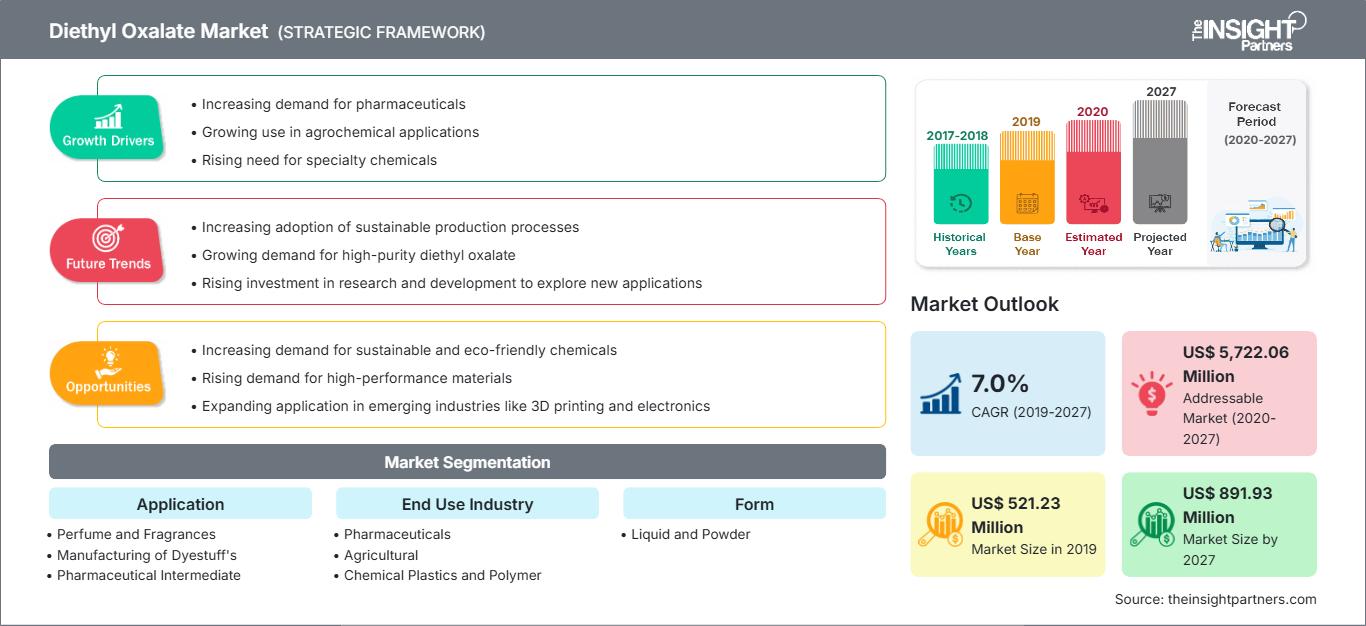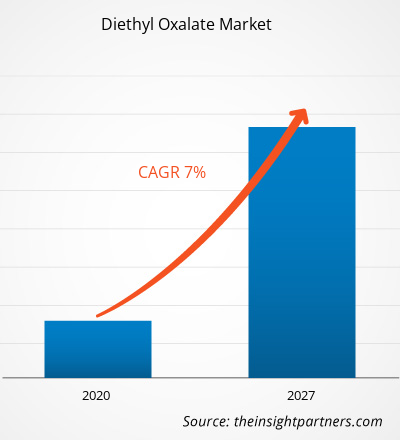Der Markt für Diethyloxalat belief sich im Jahr 2019 auf 521,23 Millionen US-Dollar und soll bis 2027 891,93 Millionen US-Dollar erreichen; von 2020 bis 2027 wird ein CAGR-Wachstum von 7,0 % erwartet.
Diethyloxalat ist als weißer Feststoff bekannt, der aus Ethanol- und Kohlenmonoxidverbindungen synthetisiert wird und die Summenformel C6H10O4 hat. Diethyloxalat wird als Zwischenprodukt oder Rohstoff für verschiedene Herstellungsverfahren verwendet. Diethyloxalat wird auch als Ethandisäure und Oxalsäurediethylester bezeichnet. Diethyloxalat ist sowohl in Pulver- als auch in flüssiger Form erhältlich. Die Verbindung wird hauptsächlich als Rohstoff oder Zwischenprodukt bei der Herstellung von Phenobarbital und zahlreichen Farbstoffen eingesetzt. Sie wird außerdem als Lösungsmittel für natürliche und Kunstharzen, auch in Nitrocelluloselacken und verschiedenen chemischen Syntheseprozessen. Darüber hinaus wird es als chemisches Zwischenprodukt bei der Synthese von pharmazeutischen Wirkstoffen verwendet. Diethyloxalat kann auch als kostengünstiger Zusatzstoff hauptsächlich auf Basis von Farbstoffsolarzellen eingesetzt werden.
Der untersuchte Markt in Nordamerika wird im Prognosezeitraum voraussichtlich mit 7,8 % die höchste durchschnittliche jährliche Wachstumsrate (CAGR) aufweisen. Das Wachstum des untersuchten Marktes in dieser Region ist hauptsächlich auf die enorme und einfache Verfügbarkeit der zur Herstellung von Diethyloxalat benötigten Rohstoffe sowie die Präsenz namhafter globaler Marktteilnehmer zurückzuführen. In Nordamerika wird Diethyloxalat häufig zur Herstellung von pharmazeutischen Wirkstoffen verwendet. Mit diesem Begriff wird die biologisch aktive Komponente eines Arzneimittels bezeichnet. Dies sind die wesentlichen Verbindungen, die bei der Herstellung von Arzneimitteln verwendet werden. Nordamerika gilt als einer der führenden Märkte für pharmazeutische Wirkstoffe und wird diese starke Position voraussichtlich noch einige Jahre behaupten. Zunehmende staatliche Initiativen im Gesundheitssektor, Innovationen im Bereich Biologika sowie eine Zunahme von Krebs und altersbedingten Erkrankungen verstärken das Wachstum pharmazeutischer Wirkstoffe in Nordamerika. Die Nachfrage nach pharmazeutischen Wirkstoffen in der Region wird voraussichtlich in Zukunft aufgrund der steigenden Krankheitszahlen und der zunehmenden geriatrischen Bevölkerung weiter steigen.
Passen Sie diesen Bericht Ihren Anforderungen an
Sie erhalten kostenlos Anpassungen an jedem Bericht, einschließlich Teilen dieses Berichts oder einer Analyse auf Länderebene, eines Excel-Datenpakets sowie tolle Angebote und Rabatte für Start-ups und Universitäten.
Diethyloxalat-Markt: Strategische Einblicke

- Holen Sie sich die wichtigsten Markttrends aus diesem Bericht.Dieses KOSTENLOSE Beispiel umfasst Datenanalysen, die von Markttrends bis hin zu Schätzungen und Prognosen reichen.
Auswirkungen von COVID-19 auf den Diethyloxalat-Markt
Sie erhalten kostenlos Anpassungen an jedem Bericht, einschließlich Teilen dieses Berichts oder einer Analyse auf Länderebene, eines Excel-Datenpakets sowie tolle Angebote und Rabatte für Start-ups und Universitäten.
Diethyloxalat-Markt: Strategische Einblicke

- Holen Sie sich die wichtigsten Markttrends aus diesem Bericht.Dieses KOSTENLOSE Beispiel umfasst Datenanalysen, die von Markttrends bis hin zu Schätzungen und Prognosen reichen.
Seit Juli 2021 gehören die USA, Indien, Brasilien, Russland, Spanien, Frankreich, Großbritannien, die Türkei und Italien zu den am stärksten betroffenen Ländern hinsichtlich bestätigter Fälle und gemeldeter Todesfälle. COVID-19 beeinträchtigt die Volkswirtschaften und zahlreiche Branchen in verschiedenen Ländern aufgrund von Lockdowns, Reiseverboten und Geschäftsschließungen. Die Schließung verschiedener Produktionsstätten und Fabriken wirkt sich ebenfalls auf die globalen Lieferketten aus und wirkt sich negativ auf die Herstellung, Lieferpläne und den Warenabsatz auf dem Weltmarkt aus. Darüber hinaus beeinträchtigen die weiteren globalen Reiseverbote, die von Ländern in Europa, im asiatisch-pazifischen Raum und in Nordamerika verhängt wurden, auch die Geschäftskooperationen sowie Partnerschaftsmöglichkeiten.
Aufgrund der Covid-19-Pandemie erleidet auch die Chemie- und Werkstoffindustrie enorme Verluste, was sich zusätzlich auf die Weltwirtschaft auswirkt. Das Transportsystem und die Rohstoffversorgung wurden zusätzlich gestört. Die unterbrochene Wertschöpfungskette hat sich negativ auf die Rohstoffversorgung ausgewirkt, was wiederum das Wachstum des Stevia-Marktes beeinträchtigt. Da die Volkswirtschaften jedoch planen, ihre Aktivitäten wieder anzukurbeln, wird die Nachfrage nach Diethyloxalat aus den Endverbraucherindustrien voraussichtlich steigen. Darüber hinaus ergreifen Chemie- und Materialhersteller einige Sicherheitsmaßnahmen zur Bekämpfung des Coronavirus, darunter die Einschränkung des direkten Kontakts mit Lieferpersonal und Besuchern, die Stärkung und Vermittlung angemessener Hygienepraktiken sowie die Durchführung vollständiger Desinfektionsmaßnahmen und die Vermeidung von Personalkontakten während Schichtwechseln. Aufgrund all dieser Faktoren ist davon auszugehen, dass die Nachfrage nach diesen Produkten in der Zeit nach der Pandemie steigen wird.
Markteinblicke: Verwendung von Diethyloxalat in der Agrochemie
Diethyloxalat wird bei der Herstellung von Agrochemikalien wie Pestiziden, Fungiziden und Herbiziden verwendet. Die Ausweitung landwirtschaftlicher Praktiken hat zu einem Anstieg der Agrochemikalienproduktion geführt und damit die Expansion des Diethyloxalat-Marktes vorangetrieben. Das explosionsartige Bevölkerungswachstum und der damit verbundene Bedarf an mehr Nahrungsmitteln, der zunehmende technologische Fortschritt in der Agrarindustrie, Fortschritte in der Pflanzenzucht, die begrenzte Verfügbarkeit von Ackerland und Management-Know-how weltweit führen zu einem verstärkten Einsatz von Agrochemikalien. Die zunehmende Einführung intensiver landwirtschaftlicher Techniken zur Steigerung der Hektarproduktivität treibt die Nachfrage nach Pestiziden an. Intensive landwirtschaftliche Techniken tragen dazu bei, den steigenden Nahrungsmittelbedarf der wachsenden Bevölkerung zu decken und Nahrungsmittelknappheit zu vermeiden. Der verstärkte Einsatz von Fungiziden, die zur Abtötung von Pilzsporen und zur Verbesserung der Erntequalität eingesetzt werden, wirkt sich ebenfalls positiv auf das Marktwachstum aus. Um die wachsende Bevölkerung mit Nahrungsmitteln zu versorgen, müssen Landwirte daher verschiedene Agrochemikalien einsetzen, um die Produktion zu steigern. Dieser Anstieg der Nutzung von Agrochemikalien wird zu einer enormen Produktion führen und in der Folge das Wachstum des Diethyloxalat-Marktes steigern.
Form Insights
Basierend auf der Form ist der globale Diethyloxalat-Markt in Flüssigkeiten und Pulver unterteilt. Das Flüssigkeitssegment hatte 2019 den größten Anteil am globalen Diethyloxalat-Markt, und das Pulversegment wird im Prognosezeitraum voraussichtlich die schnellste CAGR verzeichnen. Diethyloxalat wird zur Herstellung von pharmazeutischen Wirkstoffen (API), Kunststoffen und Farbstoffzwischenprodukten verwendet. Es wird auch als Lösungsmittel für Celluloseester, Harze, Parfüme, Ether und Lacke für die Elektronik eingesetzt. Flüssiges Diethyloxalat wird häufig zur Herstellung von Phenobarbital, Triethylamin, Ethylbenzylmalonat, ähnlichen Chemikalien und Kunststoffen verwendet.
Anwendungseinblicke
Der Diethyloxalat-Markt ist je nach Anwendung in Parfüms und Duftstoffe, Herstellung von Farbstoffen, pharmazeutische Zwischenprodukte, Weichmacher und Sonstiges unterteilt. Das Segment der Farbstoffherstellung hatte 2019 den größten Anteil am globalen Diethyloxalat-Markt, und das Segment der pharmazeutischen Zwischenprodukte wird im Prognosezeitraum voraussichtlich die höchste durchschnittliche jährliche Wachstumsrate (CAGR) verzeichnen. Farbstoffe sind anorganische oder organische, wasserlösliche Substanzen, die Licht reflektieren. Ein Farbstoff wird als Färbemittel verwendet, das die Farbe von Materialien dauerhaft verändert. Farbstoffe werden hauptsächlich zum Färben von Textilien eingesetzt. Einige der Endverbraucherbranchen, die Farbstoffe in großem Umfang verwenden, sind die Textil-, Leder- und Papierindustrie. Darüber hinaus spielen Farbstoffe in der chemischen Industrie eine wichtige Rolle bei der Aufrechterhaltung der chemischen Einheitlichkeit.
Einblicke für Endverbraucher
Der Markt für Diethyloxalat ist nach Endverbrauchern unterteilt in Pharmazeutika, Agrarprodukte, chemische Kunststoffe und Polymere, Kosmetika und Sonstiges. Das Segment der chemischen Kunststoffe und Polymere hatte 2019 den größten Anteil am globalen Diethyloxalat-Markt und das Segment Pharmazeutika wird im Prognosezeitraum voraussichtlich die höchste durchschnittliche jährliche Wachstumsrate verzeichnen. Diese werden für die Herstellung von Konsumgütern und anderen Produkten wie Beschichtungen, Schmiermitteln, Baumaterialien usw. verwendet. Polymere und Kunststoffe werden aufgrund ihrer Kosteneffizienz, hohen Leistung und ihres geringen Gewichts als Alternative zu herkömmlichen Produkten auf Mineral- oder Metallbasis eingesetzt. Neue Ansätze zur Herstellung chemischer Kunststoffe und Polymere wurden auch mit Diolen wie 1,3-Propandiol, 1,6-Hexandiol oder 1,4-Butandiol sowie Ethylenglykol in Kombination mit Diethyloxalat oder Dimethyloxalat genutzt. Die steigende Nachfrage nach Kunststoffen und Polymeren hat daher lukrative Möglichkeiten für den Diethyloxalat-Markt geschaffen.
Fusionen und Übernahmen sowie Forschung und Entwicklung sind gängige Strategien von Unternehmen, um ihre Präsenz weltweit zu erweitern, was sich zusätzlich auf die Größe des Marktes auswirkt. Die Akteure auf dem Diethyloxalat-Markt setzen die oben genannten Strategien um, um ihren Kundenstamm zu erweitern und bedeutende Marktanteile zu gewinnen, was ihnen auch ermöglicht, ihren Markennamen weltweit zu behaupten.
Diethyloxalat-Markt
Die Analysten von The Insight Partners haben die regionalen Trends und Faktoren, die den Diethyloxalat-Markt im Prognosezeitraum beeinflussen, ausführlich erläutert. In diesem Abschnitt werden auch die Marktsegmente und die geografische Lage von Diethyloxalat in Nordamerika, Europa, im asiatisch-pazifischen Raum, im Nahen Osten und Afrika sowie in Süd- und Mittelamerika erläutert.Umfang des Marktberichts über Diethyloxalat
| Berichtsattribut | Einzelheiten |
|---|---|
| Marktgröße in 2019 | US$ 521.23 Million |
| Marktgröße nach 2027 | US$ 891.93 Million |
| Globale CAGR (2019 - 2027) | 7.0% |
| Historische Daten | 2017-2018 |
| Prognosezeitraum | 2020-2027 |
| Abgedeckte Segmente |
By Anwendung
|
| Abgedeckte Regionen und Länder | Nordamerika
|
| Marktführer und wichtige Unternehmensprofile |
|
Dichte der Marktteilnehmer für Diethyloxalat: Verständnis ihrer Auswirkungen auf die Geschäftsdynamik
Der Markt für Diethyloxalat wächst rasant. Die steigende Nachfrage der Endverbraucher ist auf Faktoren wie veränderte Verbraucherpräferenzen, technologische Fortschritte und ein stärkeres Bewusstsein für die Produktvorteile zurückzuführen. Mit der steigenden Nachfrage erweitern Unternehmen ihr Angebot, entwickeln Innovationen, um den Bedürfnissen der Verbraucher gerecht zu werden, und nutzen neue Trends, was das Marktwachstum weiter ankurbelt.
- Holen Sie sich die Diethyloxalat-Markt Übersicht der wichtigsten Akteure
- Progressive Branchentrends auf dem globalen Diethyloxalat-Markt, um Akteuren bei der Entwicklung effektiver langfristiger Strategien zu helfen
- Geschäftswachstumsstrategien von Unternehmen in entwickelten und sich entwickelnden Märkten
- Quantitative Analyse des globalen Diethyloxalat-Marktes von 2017 bis 2027
- Schätzung der globalen Nachfrage nach Diethyloxalat, die von verschiedenen Branchen generiert wird
- PEST-Analyse zur Veranschaulichung der Wirksamkeit von Käufern und Lieferanten, die im Diethyloxalat-Ökosystem tätig sind
- Jüngste Entwicklungen zum Verständnis des wettbewerbsorientierten Marktszenarios und der globalen Nachfrage nach Diethyloxalat
- Markttrends und -aussichten, gepaart mit Faktoren, die das Wachstum des globalen Diethyloxalat-Marktes vorantreiben und hemmen
- Einblicke zur Unterstützung des Entscheidungsprozesses durch das Verständnis von Strategien, die das kommerzielle Interesse im Hinblick auf das Wachstum des Diethyloxalat-Marktes weltweit untermauern
- Globale Größe des Diethyloxalat-Marktes an verschiedenen Knotenpunkten des Markt
- Detaillierter Überblick und Segmentierung des globalen Diethyloxalat-Marktes sowie der Dynamik der Diethyloxalat-Branche
- Globale Größe des Diethyloxalat-Marktes in verschiedenen Regionen mit vielversprechenden Wachstumschancen
Diethyloxalat-Markt – nach Anwendung
- Parfüm und Duftstoffe
- Herstellung von Farbstoffen
- Pharmazeutische Zwischenprodukte
- Weichmacher
- Sonstige
Diethyloxalat-Markt – nach Form
- Flüssig
- Pulver
Diethyloxalat-Markt – nach Form
- Flüssig
- Pulver
Diethyloxalat-Markt – Nach Endbenutzer
- Pharmazeutika
- Landwirtschaft
- Chemische Kunststoffe und Polymere
- Kosmetik
- Andere
Firmenprofile
- BorsodChem MCHZ, sro
- Nanjing Chengyi Chemical Co., Ltd
- Indisches Oxalat Ltd.
- Chemamde
- Merck KGaA
- Mudanjiang Hongli Chemicals
- Tokyo Chemical Industry
- Ube Industries
- Vertullus Holdings
- Zibo Xusheng Chemical Co., Ltd
- Historische Analyse (2 Jahre), Basisjahr, Prognose (7 Jahre) mit CAGR
- PEST- und SWOT-Analyse
- Marktgröße Wert/Volumen – Global, Regional, Land
- Branchen- und Wettbewerbslandschaft
- Excel-Datensatz
Aktuelle Berichte
Erfahrungsberichte
Grund zum Kauf
- Fundierte Entscheidungsfindung
- Marktdynamik verstehen
- Wettbewerbsanalyse
- Kundeneinblicke
- Marktprognosen
- Risikominimierung
- Strategische Planung
- Investitionsbegründung
- Identifizierung neuer Märkte
- Verbesserung von Marketingstrategien
- Steigerung der Betriebseffizienz
- Anpassung an regulatorische Trends




















 Kostenlose Probe anfordern für - Diethyloxalat-Markt
Kostenlose Probe anfordern für - Diethyloxalat-Markt